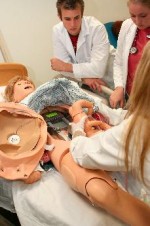Machine gives birth to nursing knowledge

The College of Nursing is able to give students a hands-on experience with labor and delivery without going to a hospital, thanks to a robotic birthing simulator named Noelle.
Nursing students take part in the simulated birthing process in the college’s Center for Virtual Learning and, although the college has had Noelle for five years, it wasn’t until the last few years that the simulation was incorporated into the curriculum, said Laura Gonzalez, a nursing instructor and the director of the Virtual Simulation and Clinical Experience.
“Because there is limited space in the hospitals and limited hours and opportunities, we needed to increase the simulations in the classroom and in the lab setting to meet that deficit,” Gonzalez said. “That’s kind of why we said we really need to ramp up our simulation.”
Jenny Molloy, a nursing instructor, has been using Noelle for two semesters.
“My perspective is that it is a great experience,” Molloy said. “It’s low-volume, high-acuity scenarios that they can put their hands on and won’t really understand from reading it out of a textbook.”
Noelle can simulate a number of different birthing situations and complications.
In Molloy’s Women’s Health Nursing class Thursday, Noelle had a problem with her baby called dystocia, which is when the infant’s shoulder gets caught on the mother’s pubic bone. Dystocia can be one of the most frightening emergencies in the delivery room, according to the American Academy of Family Physicians.
In order to birth the simulated baby safely, the nurses-in-training and the instructor turned the baby in a somersault-like motion when pulling it out of the birth canal.
Groups of five to seven students worked with Noelle throughout the day. Molloy let the students work out what they should do, guiding them when necessary. Several students thought the experience was beneficial.
“I love working with Noelle. As a student it is hard to be able to get in there, in the hospital, when the nurses and the doctors are all dealing with (the patient) – you kind of stand toward the side,” said Krysta Valiquette, a senior nursing student.
“But it’s fun to be able to get in there and see what’s going on. You can lift the abdomen and you can see how the baby is turning in the uterus and descending from the birth canal.”
Molloy believes more practice with a birthing simulator will help students prepare for real births and emergencies.
“The more practice they have, the more things they will remember that they need to do,” Molloy said. “There is no substitute for experience.”
Molloy tries to have a provider – the technical term for someone who helps give birth – in the lab with the students so they can experience what it would be like to assist a real doctor or midwife in the delivery room.
“We approach it from a nursing perspective,” Molloy said. “From what the clinical presentation is and how they would respond. How they would communicate with the provider.”
The students worked with Cecilia Jevitt, a midwife and associate professor of nursing and obstetrics/gynecology who holds a doctorate in nursing.
The students are given a patient history and timetable of events. They must answer questions from the provider, assist the birth, take care of the simulator baby and write reports.
After the baby was born, cleaned and deemed healthy, the instructor placed it on Noelle’s abdomen, as nurses would do after a real birth. Though there was an umbilical cord, it was not snipped, as it was not attached to the mother.
The placenta – the fluid sac protecting the baby in the womb – came after the baby, but did not require cleanup as it, too, was plastic.
After the birth, Noelle’s belly was opened so the baby could be put back in, just in time for the next birth.
“They take it very seriously,” said Molloy of the simulation. “Once they get into it, it becomes very real for them.






